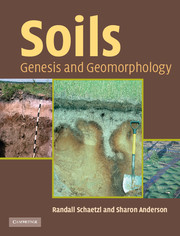Book contents
- Frontmatter
- Contents
- Preface
- Acknowledgements
- Part I The building blocks of the soil
- 1 Introduction
- 2 Basic concepts: soil morphology
- 3 Basic concepts: soil horizonation … the alphabet of soils
- 4 Basic concepts: soil mineralogy
- 5 Basic concepts: soil physics
- 6 Basic concepts: soil organisms
- 7 Soil classification, mapping and maps
- Part II Soil genesis: from parent material to soil
- Part III Soil geomorphology
- References
- Glossary
- Index
2 - Basic concepts: soil morphology
from Part I - The building blocks of the soil
- Frontmatter
- Contents
- Preface
- Acknowledgements
- Part I The building blocks of the soil
- 1 Introduction
- 2 Basic concepts: soil morphology
- 3 Basic concepts: soil horizonation … the alphabet of soils
- 4 Basic concepts: soil mineralogy
- 5 Basic concepts: soil physics
- 6 Basic concepts: soil organisms
- 7 Soil classification, mapping and maps
- Part II Soil genesis: from parent material to soil
- Part III Soil geomorphology
- References
- Glossary
- Index
Summary
Soil means diffferent things to different people. To a farmer or horticulturalist, it is a medium for plant growth. To an engineer, it is something to build on or remove before construction can occur, or it may actually be a type of engineering medium used for road building, house foundations or septic drain fields. To a hydrologist soil functions as a source of water purification and supply. To the pedologist or soil geographer, however, soil is a natural, three-dimensional body that has formed at the Earth's surface, through the interactions of at least five soil-forming factors (climate, biota, relief, parent materials and time). Its genesis involves past processes and it is likely to change in the future. It varies spatially in the horizontal and vertical dimensions. It is capable of being destroyed and yet it is resilient to perturbations.
Each soil also has a distinct morphology, defined as its structure or form. Soil morphology is all that can be seen and felt about a soil. It includes not only “what is there” but also how it is “put together” – its architecture. Soil's other defining characteristics, such as horizonation, chemistry and mineralogy, are discussed in later chapters.
Soils are composed of clastic particles (mineral matter), organic materials in various stages of decay, living organisms, water (or ice), and gases within pores of various sizes (Fig. 2.1). The absolute amounts of each, and their arrangement into a particular fabric, are the sum of soil morphology.
- Type
- Chapter
- Information
- SoilsGenesis and Geomorphology, pp. 9 - 31Publisher: Cambridge University PressPrint publication year: 2005
- 1
- Cited by

